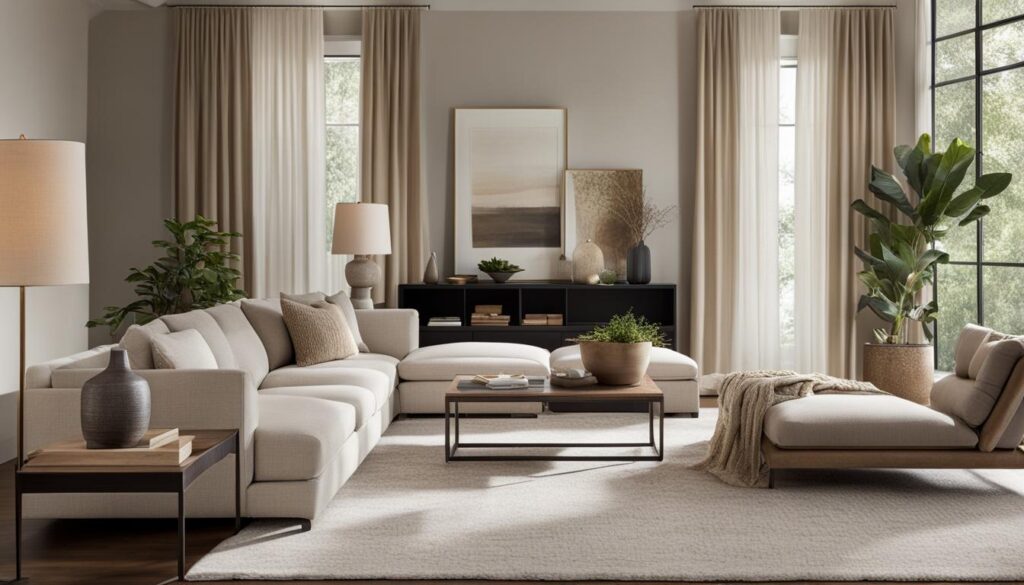Decorating a long narrow living room can be a challenge, but with the right strategies, you can transform it into a functional and visually appealing space. Here are some tips to help you make the most of your long narrow living room.
Table of Contents
Key Takeaways:
- Creating separate zones can maximize the space in a long narrow living room.
- Alternating furniture groupings can create a more dynamic layout and prevent the room from feeling like a straight hallway.
- Arranging furniture cross-wise can visually push the walls outward, creating the illusion of a wider space.
- Utilizing the middle of the room and working with an L-shaped sofa can optimize the functionality of a long narrow living room.
- By following these tips, you can turn your seemingly limited space into a stylish and inviting area.
Creating Separate Zones
One of the key strategies for decorating a long narrow living room is to create separate zones within the space. This is especially important in open-plan spaces where the living room seamlessly transitions into other areas of the home. By defining separate zones, such as a smaller living area, a den, a study area, or a breakfast nook, you can make the most of the available space and add functionality to the room.
To create these separate zones, you can use various design elements such as rugs, lights, and color. Placing a rug under each designated zone can help visually differentiate the areas and create a sense of purpose. Additionally, using different lighting fixtures, such as floor lamps or pendant lights, for each zone can further enhance the distinction between them.
Color can also play a crucial role in zoning a long narrow living room. You can use paint or wallpaper to create accent walls or employ different color schemes for each zone. This not only helps delineate the areas but also adds visual interest and depth to the space.
Creating a Den as a Separate Zone
One popular way to create a separate zone in a long narrow living room is to incorporate a den. A den can serve as a cozy retreat or entertainment area, providing a distinct space away from the main living area. This can be achieved by using a different seating arrangement, such as comfortable armchairs or a small sofa, and adding elements like a bookshelf or a media console.
A den can be a versatile space, serving multiple functions depending on your needs. It can be a quiet reading nook, a dedicated TV-watching area, or even a small home office. By incorporating a den into your long narrow living room, you can add depth and functionality to the overall design.
| Separate Zones | Description |
|---|---|
| Smaller Living Area | Create a cozy, intimate seating area for everyday use. |
| Den | Designate a separate space for relaxation, entertainment, or work. |
| Study Area | Create a dedicated space for work or study by incorporating a desk and storage. |
| Breakfast Nook | Add a small dining table or bar stools to create a designated dining area. |
Alternating Furniture Groupings
When decorating a long narrow living room, it’s important to consider the traffic flow and how to make the space feel less like a straight hallway. One effective strategy is to alternate furniture groupings throughout the room. Instead of placing all the furniture on one side of the long wall, distribute it in a way that creates an “S” shape, encouraging a more dynamic layout.
By alternating furniture groupings, you not only utilize the space more effectively but also prevent the room from feeling cramped and uninviting. It allows for better movement and flow, as well as creating visually interesting spaces within the room. You can consider placing a seating area on one end, then a console table with a mirror on the other side, and perhaps a reading nook near a window.
Another benefit of alternating furniture groupings is that it can help define different zones within the room. For example, you can create a cozy conversation area with a sofa and chairs, then a separate area with a desk for a home office or a small dining table for meals. This way, you maximize the functionality of the space while maintaining a cohesive design.
Design Tip: Utilizing Space
When working with a long narrow living room, one of the keys to successful design is utilizing the space effectively. By alternating furniture groupings, you are able to make the most of the length and width of the room. It allows you to create distinct areas for different activities, making the room feel more purposeful and organized.
Remember to consider the scale of the furniture and how it fits in each grouping. Avoid overcrowding or placing pieces that are too large for the space. It’s important to strike a balance between functionality and aesthetics. Utilize smaller pieces, such as armchairs or ottomans, to add flexibility and create more seating options.
By carefully planning and arranging furniture in an alternating manner, you can transform your long narrow living room into a harmonious and visually appealing space that is both functional and inviting.
| Benefits of Alternating Furniture Groupings | Examples of Alternating Furniture Groupings |
|---|---|
|
|
Arranging Furniture Cross-Wise
When it comes to decorating a long narrow living room, arranging furniture cross-wise can work wonders in creating a visually spacious and inviting atmosphere. By strategically placing furniture in this manner, you can visually push the walls outward, giving the room a wider appearance.
Instead of opting for a single long sofa against the longer wall, consider using two shorter sofas placed width-wise in the room. This not only breaks up the space but also adds a sense of balance and proportion. To further enhance the effect, you can repeat this technique with other furniture pieces like console tables and bookshelves.
Arranging furniture cross-wise not only creates an illusion of a wider space but also improves the flow and functionality of the room. It allows for easier navigation and prevents the room from feeling like a cramped hallway. By distributing furniture throughout the room, you can make the most of the available space and create a layout that is both practical and visually appealing.
FAQ
How can I create separate zones in a long narrow living room?
To create separate zones in a long narrow living room, you can designate smaller living areas, den, study area, or breakfast nook. Use rugs, lights, and/or color to define and differentiate the spaces.
What is the benefit of alternating furniture groupings in a long narrow living room?
Alternating furniture groupings in a long narrow living room creates a more dynamic layout and prevents it from feeling like a straight hallway. This helps distribute furniture throughout the room and make it feel more functional and inviting.
How can arranging furniture cross-wise help in a long narrow living room?
Arranging furniture cross-wise in a long narrow living room visually pushes the walls outward, creating the illusion of a wider space. Using two shorter sofas width-wise can achieve this effect, along with other furniture pieces like console tables and bookshelves.


